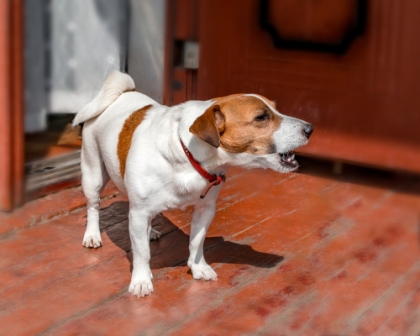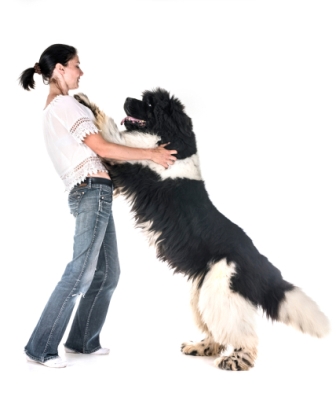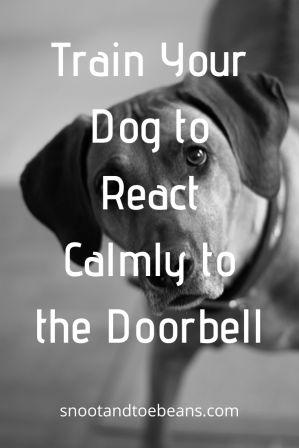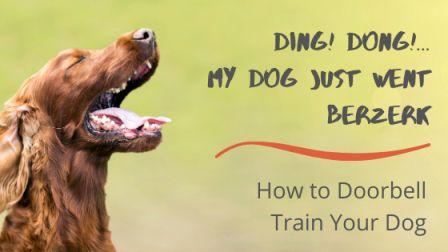Disclosure: My dog blog is supported by dog parents just like you. I only recommend products that I would use on my dogs. All opinions expressed here are my own. I sometimes earn a small affiliate commission, at no extra cost to you, when you click through the affiliate link and purchase something. You can read more about my affiliate policy here.

January is National Train Your Dog Month. Therefore, one of my New Year’s resolutions for 2020 is to work on doorbell training my dog, Edward. I need him to not go crazy every time he hears it. Furthermore, both of my dogs need to greet whoever is on the other side, with some doggy politeness.
Edward is oblivious to the television blaring the sound of a football game. But, let me tell you when a commercial blares a ringing doorbell, he absolutely loses his mind. He frantically barks, whines and paces back and forth by the front door. He is in a complete state of frenzy imagining a terrifying someone on the other side. In addition, he’s ready to protect me with all of his nine pounds.
Then there are the times that the house doorbell rings. So, then his frenzy behavior is in anticipation of an old or a new friend. Nonetheless, both real or commercial produced, that little “ding-dong” sound brings on anxiety for my little guy. He jumps at his own reflection in his food bowl.
Research for Doorbell Training My Dog
The last time Edward went into a frenzy state after hearing the doorbell ring from the television speaker, I opened the front door to show him that nobody was on the porch. It was then that I realized I shouldn’t try doorbell training my dog in the moment of his panic attack. Also, when someone really is there, I shouldn’t try to train him in that moment on how to greet the visitor.
So, my first training step has been to acknowledge that I need to work on doorbell training my dog. I no longer want him to go into a frenzy state every time he hears our doorbell or a doorbell on the television. Plus, I also want him and his sister, Bella to learn how to properly greet someone when they really are on the other side of the door.

In my research to begin doorbell training my dog, I discovered that one of the common reasons dog owner’s hire a dog trainer is to help calm down the frenzied behavior at the front door.
I also found that when a dog or puppy first comes home is the best time to train preferred doorbell behavior. Well, darn! Edward is 8-years-old and yes, I’ve heard the old saying, “you can’t teach an old dog a new trick”. Well…we will see about that!
My old boy is going to learn to not overreact to a doorbell ringing whether it really does or he just hears it on television. He as well as his sister are going to learn how to properly greet humans, whether known visitors or strangers.
Following is my plan for doorbell training my dog…
Make a Couple of Purchases
A handheld remote doorbell device either from Amazon, Lowe’s or Home Depot would give me the opportunity to practice without bugging someone to really be outside the door pressing the doorbell. My second purchase will be tiny training treats. I say tiny here, because it can take several treats during ANY training process. Any of the Dog Chef recipes on my Dog Blog could be made as training treats. I would just need to cut the dough into tiny pieces.
On to doorbell training my dog…
Condition To Expect A Treat
I will ring the remote doorbell and immediately feed Edward a treat. Yep, he is totally going to be acting crazy, which is a symptom of his excitement. That symptom can’t be reinforced just because I give him a treat. So, it does not matter if he is barking and acting crazy, I’m still going to give him a treat, even if I have to throw it on the floor for him to realize he is being treated. My goal is for him to come to me for a treat when he hears the doorbell instead of going crazy. The quicker he does this, the quicker I can start working on a new behavior. I will continue to ring the bell every 15 seconds for 5 to 10 repetitions. I will practice with him at different times. Once he is coming to me every time for a treat, then we will move on to the new behavior.
Train To Stay in a Spot
I am on the fence as to where I want his “sit and stay” place to be. A part of me wants it to be away from the front door and another part of me wants it to be close to the front door where he can see who is there. However, with either one, it is important to point out that teaching this behavior is also for his safety. I live on a very busy street and I don’t want him dashing out of the front door
- I need to teach him a stay, so I will have him sit and say “stay”. Then I will take one step back. If Edward holds his stay, I will use a “marker word” to mark the behavior, and then return and treat him. I will slowly increase the number of steps until I build up distance away from him.
- I will use the same spot each and every time.
- Now, I will bring “opening the front door” into play for the next part of his training. Edward will need to be in his “stay spot”. After I give him his stay cue, I will head to the door. I know there is a possibility of him breaking position, because the door will be very tempting. I just can’t let myself get discouraged if the progress is slow. We will work in short sessions of two to three minutes until I can open the door and he doesn’t move.
- Next, I will add my husband, Javi, outside of the door. We will repeat the stay process until I can open the door and let Javi in. If Edward breaks his stay, I will need to close the door without letting Javi in. Hopefully, Edward will realize that the only way he gets to see his daddy is if he holds his stay.
Keep From Reacting to the Doorbell
It will be time to add the doorbell after Edward is able to hold his stay once the door is opened with Javi on the other side. So, now several things will need to happen back to back.
- Ring the bell and feed a treat where I want Edward to stay.
- I will tell him to stay and open the door without anyone outside. If he holds his stay, I will reward him with several treats.
- Next, after several times of holding his stay, I will add Javi outside. Then, we will repeat the process until he can hold his stay while Javi enters.
You might find this YouTube video helpful for doorbell training.
Now I can move on to training both of my dogs on doggy politeness…
How to React to the Visitor
I want Bella and Edward, both to greet the visitor on the other side of the door with doggy politeness. We do not get a whole lot of visitors to our house, but when we do, my furries whine and bark at them when they enter the house. Sometimes, Bella even gets so excited that she piddles on the floor. And, they both always jump up on the visitor.
The Importance of Socializing
If a dog is not used to being around strangers very often, then they will have an unacceptable reaction to visitors. Obviously from the paragraph above, Bella and Edward have not been around a lot of strangers. We are working on this now, even though they are older.
For those of you with a new dog, either puppy or adopted older dog, it is important to properly socialize him or her. Check out this post on socialization. The more a dog is around strangers, the more polite they will be when a guest arrives at your house.
Helping With Doggy Politeness
I can help Bella and Edward learn to have doggy politeness by using any of the following techniques:
• A Safe Space
Bella and Edward love their beds where they feel safe. I can train them to go to their beds with a simple command whenever someone comes over. I can reward them with a treat or a non-rawhide chew.

•“Stay” “Down” and “No”
I can reinforce these commands to help Bella and Edward remember that I am in control. This will also help them learn that their reactions are not polite.
•Using a Leash
We keep Bella and Edward’s leashes close to the door. I can teach them that when someone comes to the door, their leashes go on. I can minimize their jumping this way.
•Go Outside to Greet
Bella and Edward do not have territorial issues, so this one is for those of you who have dogs that do. A territorial dog may be more comfortable greeting a visitor in a neutral area. The visitor can go on in and you and your dog can enter a little bit after.
•Greet Confidently, Especially With a Known Visitor
Bella and Edward always watch my reaction to things. So, if I comfortably greet a visitor by using a good vocal tone, then they will know this person can be trusted if the person is a stranger. I can even hug or shake the visitor’s hand, so they have my scent to help Bella and Edward be more accepting.
•Proper Introductions
Dogs learn about things and people by sniffing. I need to allow Bella and Edward to greet the visitor in their own way. I can help with this by asking my visitor to put their hands down to their noses for them to sniff. Now for those of you with big dogs, you will want to teach your dog to not sniff a visitor’s “tush” in an effort to get to know them.
•Good Behavior Gets Rewarded
When Bella and Edward respond appropriately to my commands and to the visitor, I will reward their behavior either with words of praise, a rub on the head, or a treat. This will help to reinforce their good behavior for future visits.
You might find this YouTube video useful for training unwanted jumping from your dog.
Conclusion
More than likely, all of these techniques to greet a visitor will not work with my furries. However, I feel if I use some of them, Bella and Edward will be on the road to doggy politeness with the visitors and strangers they come in contact with, and with consistent training, Edward will no longer go crazy at the sound of a doorbell.
If you have tips that will help me with my New Year’s resolution, please let me know in the comments below.
If you want to save this post to Pinterest for future reference, pin one of the following images.




